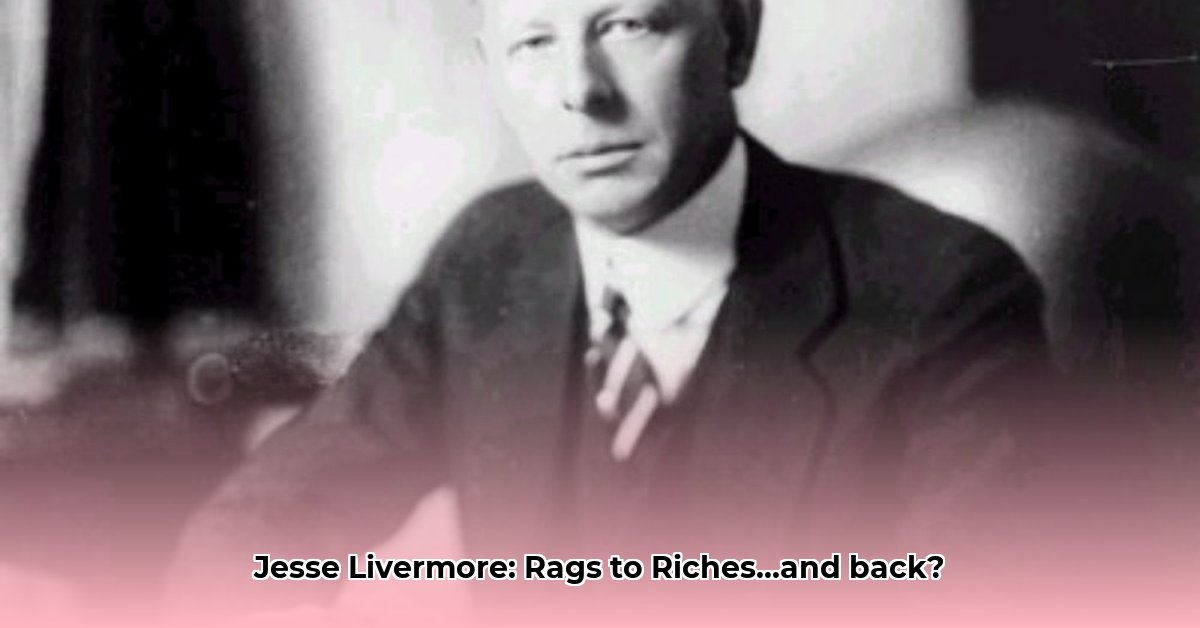
Jesse Livermore's life story is a compelling narrative of financial triumph and devastating failure, a rollercoaster ride that captivates and cautions in equal measure. His journey, from humble beginnings to unparalleled wealth and back again, offers invaluable lessons about market dynamics, risk management, and the crucial role of emotional discipline in high-stakes trading. While precise figures for his net worth remain elusive due to incomplete historical records, analyzing his career provides a fascinating glimpse into the volatile world of Wall Street, illustrating both the allure and the peril of financial speculation.
A Meteoric Rise: Livermore's Early Successes
Livermore's career began modestly, marked by an uncanny ability to predict market shifts. He wasn't simply lucky; his success stemmed from meticulous market research and a keen understanding of technical analysis (the study of past market data to predict future trends). This early success, built on his sharp intuition and diligent study, laid the foundation for his future fortune. By the 1920s, he was a Wall Street legend, his name synonymous with exceptional trading prowess. His net worth soared, reaching an estimated $100 million by 1929 – a figure representing billions in today's value. This wasn't mere chance; it was the result of mastering the complex interplay of market forces. Did his astute understanding of market psychology contribute to his unparalleled success? Undoubtedly, his ability to anticipate shifts in investor sentiment was a crucial part of his trading strategy.
The Great Crash of 1929: A Crushing Blow
The 1929 stock market crash served as a stark reminder of the inherent risks in even the most carefully calculated investments. Despite his reputation and strategic use of short selling—betting against the market—Livermore suffered significant losses. The sheer scale of the crash impacted even the most skillful traders, highlighting the unpredictable nature of market downturns. This event dramatically altered his net worth, underscoring the vulnerability of even the most accomplished investors to unforeseen market forces. How did Livermore's experience during the crash influence his subsequent trading strategies? His losses arguably led him to refine his approach to risk management, a lesson he would repeatedly grapple with throughout his career.
A Pattern of Extremes: Rebuilding and Subsequent Setbacks
Undeterred by his losses, Livermore relentlessly pursued financial success. He demonstrated remarkable resilience and an unwavering determination to rebuild his fortune. However, a cyclical pattern emerged: periods of extraordinary wealth were followed by dramatic declines. This recurring pattern suggests possible weaknesses in his risk management strategies or perhaps vulnerabilities to emotional influences in his decision-making process. Did these setbacks stem from insufficient diversification of his investments or an overreliance on his intuition? While the exact reasons remain speculative, the cyclical nature of his fortune underscores the enduring challenge of maintaining financial success in the unpredictable world of market trading.
The Final Chapter: A Cautionary Legacy
Livermore's final years were marked by persistent financial struggles. His tragic suicide in 1940 left a lasting legacy, a cautionary tale highlighting both the extraordinary potential for success and the devastating consequences of risk-taking in high-stakes trading. His story is far more nuanced than a simple "rags to riches" narrative; it's a complex tale of achievement, resilience, and devastating setbacks, offering profound lessons for both seasoned and aspiring traders alike. What can modern investors learn from the emotional and financial pitfalls of Livermore's career? The necessity of robust risk management and the critical importance of emotional discipline remain key takeaways from his story.
Key Lessons from Livermore's Life:
- Technical Analysis is Paramount: Livermore's early triumphs were directly linked to his mastery of technical analysis. It wasn't mere speculation; it was meticulous research and data-driven analysis.
- Risk Management is Non-negotiable: The magnitude of his setbacks underscores the critical importance of effective risk management. Even exceptional skills are insufficient without a disciplined approach to risk.
- Emotional Discipline is Key: Livermore's financial rollercoaster demonstrates the devastating impact of emotional impulses on investment decisions. Maintaining a detached, objective perspective is crucial.
Livermore's Net Worth: A Broad Overview
Precise figures for Livermore's net worth are unavailable. However, a general picture of his fluctuating wealth can be constructed:
| Year (Approximate) | Estimated Net Worth (USD) | Context |
|---|---|---|
| 1920s | Millions | Significant early success in a booming market. |
| 1929 | ~$100 million (1929 USD) | Peak net worth, preceding the 1929 crash. |
| 1930s | Fluctuating, substantial losses | Periods of rebuilding interspersed with further setbacks. |
| 1940s | Significantly diminished | Final years marked by considerable financial hardship. |
This data represents estimates, not precise figures. The true significance lies not in the exact numbers but in the extreme fluctuations that define Livermore's career, a testament to the unpredictable nature of market forces and the human element in trading. His legacy serves as a reminder of the importance of both skill and self-control in the often unforgiving world of finance.